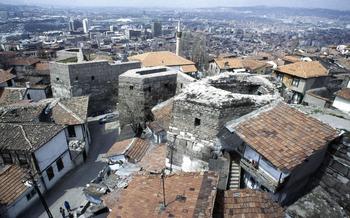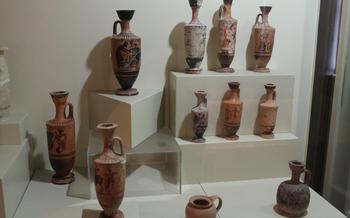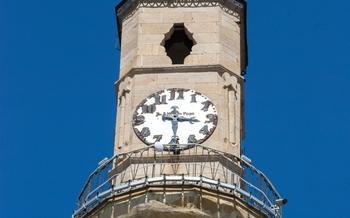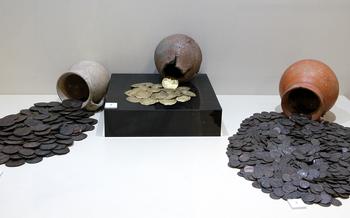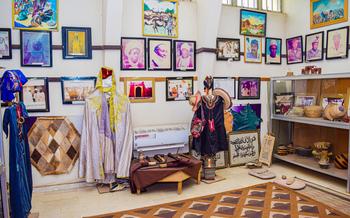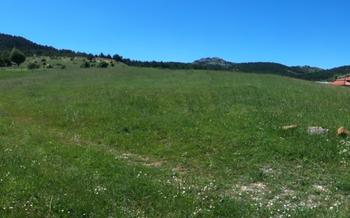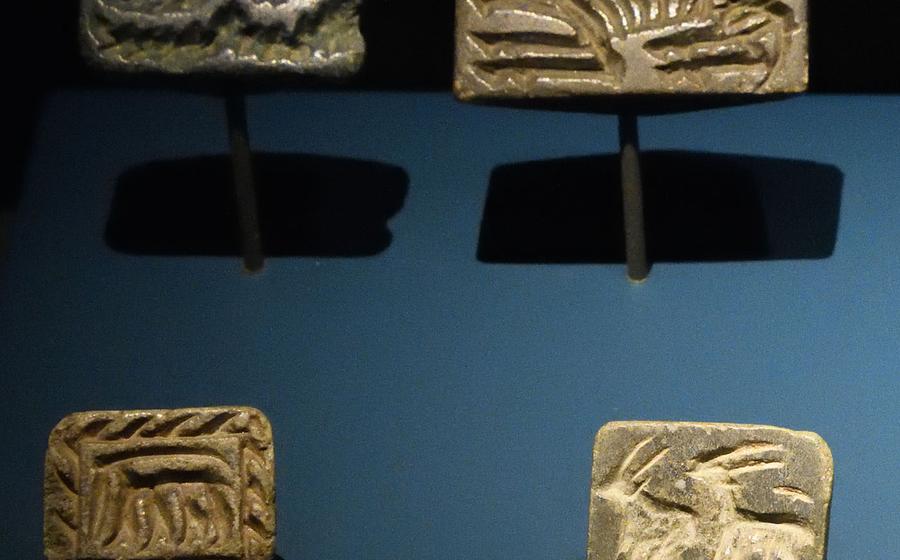
Adana Archaeology Museum
- Adana Archaeology Museum: A Treasure Trove of History
- Location and Accessibility
- Opening Hours and Admission Fees
- History and Architecture of the Museum Building
- Exhibits and Collections
- Statues and Sculptures: Masterpieces of Ancient Craftsmanship
- Mosaics and Frescoes: A Journey Through Ancient Art
- Exquisite Masterpieces Adorning the Walls
- Jewelry and Ornaments
- Weapons and Armor
- Coins and Currency
- Inscriptions and Epigraphy
- Textiles and Costumes
- Temporary Exhibits and Special Events
- Insider Tip: Guided Tours and Workshops
Adana Archaeology Museum: A Treasure Trove of History
The Adana Archaeology Museum, nestled in the heart of the vibrant city of Adana, Turkey, stands as a testament to the region's rich historical legacy. This remarkable institution houses a treasure trove of artifacts, each telling a captivating tale of ancient civilizations that once flourished in this land.
As you step through the museum's doors, you'll be transported back in time, surrounded by relics that whisper stories of bygone eras. From exquisite mosaics depicting scenes of daily life to imposing statues of ancient deities, the museum's exhibits offer a glimpse into the diverse cultures that have shaped Turkey's history.
One of the highlights of the museum is its impressive collection of Hittite artifacts. The Hittites, a powerful civilization that ruled over Anatolia during the Bronze Age, left behind a legacy of awe-inspiring sculptures, intricate jewelry, and cuneiform tablets. These artifacts provide valuable insights into their sophisticated writing system, religious beliefs, and artistic prowess.
Another must-see exhibit is the collection of Roman mosaics. These intricate works of art, discovered in various archaeological sites around Adana, showcase the Romans' mastery of mosaic craftsmanship. The mosaics depict a variety of subjects, from mythological scenes to hunting expeditions, offering a glimpse into the lives and beliefs of the Roman inhabitants of the region.
The Adana Archaeology Museum is not just a repository of ancient treasures; it also serves as a vital institution dedicated to preserving Turkey's rich cultural heritage. Through its ongoing research and conservation efforts, the museum ensures that these precious artifacts remain accessible to future generations, allowing them to appreciate the enduring legacy of the civilizations that once called this land home.
Location and Accessibility
The Adana Archaeology Museum is conveniently situated in the heart of the city, at the following address: Kurtuluş Mahallesi, Dumlupınar Bulvarı, 01010 Seyhan/Adana, Turkey.
Reaching the museum is a breeze, thanks to its excellent public transportation links. Several bus lines, including the 139, 141, and 142, stop right outside the museum, making it effortlessly accessible from all parts of the city.
For those who prefer the convenience of driving, the museum offers ample parking space, although fees may apply. It's recommended to arrive early to secure a spot, especially during peak tourist season.
To avoid the crowds and ensure a more tranquil visit, consider planning your trip outside of the typical tourist rush hours. Weekdays, early mornings, and late afternoons are generally quieter times to explore the museum's treasures.
Opening Hours and Admission Fees
The Adana Archaeology Museum welcomes visitors with open arms every day of the week, except for Mondays. Its doors are open from 8:30 AM to 5:30 PM, providing ample time to explore its treasures. However, it's worth noting that the museum observes shorter hours during the winter months, from November 1st to April 1st, when it closes at 5:00 PM.
Admission fees are quite reasonable, ensuring that everyone has the opportunity to immerse themselves in the wonders of ancient history. Adults can purchase a ticket for 20 Turkish Lira, while students can enjoy a discounted rate of 10 Turkish Lira. Children under the age of 12 are granted free admission, making it a fantastic family-friendly destination.
To enhance your visit and gain deeper insights into the museum's artifacts, guided tours are available in various languages. These tours typically have a small additional fee, but they offer a wealth of knowledge and make the experience even more enriching. So, whether you're a history buff, an art enthusiast, or simply curious about Turkey's rich cultural heritage, the Adana Archaeology Museum is a must-visit destination.
History and Architecture of the Museum Building
The Adana Archaeology Museum is housed in a magnificent building that is as impressive as the artifacts it contains. Constructed between 1924 and 1932, the museum's architecture is a blend of traditional Turkish and modern European styles. The building features a grand entrance with a portico supported by massive columns, reminiscent of ancient Greek temples. Its exterior walls are adorned with intricate carvings and decorative motifs that showcase the region's rich cultural heritage.
Inside, the museum's spacious galleries are designed to maximize natural light, allowing visitors to appreciate the exhibits in their full glory. The layout is well-organized, with each section dedicated to a specific era or civilization, making it easy for visitors to navigate and explore the museum's vast collection.
One of the most intriguing aspects of the museum's history is its connection to the famous archaeologist, Mustafa Kemal Atatürk. Atatürk, who is revered as the father of modern Turkey, played a pivotal role in establishing the museum and ensuring its preservation. His vision for the museum was to create a repository of Turkey's rich cultural heritage and to showcase the country's contributions to world civilization.
Today, the Adana Archaeology Museum stands as a testament to Atatürk's vision and to the enduring legacy of the many civilizations that have shaped Turkey's history. Its impressive architecture, combined with its world-class collection of artifacts, makes it a must-visit destination for anyone interested in the history and culture of this fascinating country.
Exhibits and Collections
The Adana Archaeology Museum houses a diverse array of exhibits and collections, each offering a glimpse into the rich history and diverse cultures of the region. The museum is divided into several sections, each dedicated to a specific era or theme.
In the prehistory section, visitors can marvel at artifacts from the Stone Age, including tools, weapons, and pottery. The ancient Near Eastern section showcases an impressive collection of cuneiform tablets, seals, and figurines, providing insights into the civilizations of Mesopotamia and Anatolia.
The Roman and Byzantine section features a variety of objects from the Roman and Byzantine periods, including sculptures, mosaics, and jewelry. The Islamic section houses a collection of Islamic art and artifacts, including ceramics, metalwork, and textiles.
The museum also boasts a numismatic collection, displaying coins from various periods of history, as well as an epigraphic collection, featuring inscriptions and texts in different languages and scripts. These collections offer valuable insights into the economic and cultural interactions of ancient civilizations.
Another highlight of the museum is its collection of textiles and costumes. Visitors can admire traditional garments, weavings, and embroideries from different regions of Turkey, providing a glimpse into the country's rich textile heritage and craftsmanship.
Statues and Sculptures: Masterpieces of Ancient Craftsmanship
Among the many treasures housed within the Adana Archaeology Museum, the collection of statues and sculptures stands out as a testament to the artistic prowess of ancient civilizations. These exquisite works of art, carved from stone, marble, and bronze, offer a glimpse into the lives, beliefs, and artistic traditions of the people who created them.
One of the most notable pieces is a stunning marble statue of a Roman emperor, believed to be Hadrian, the emperor who ruled from 117 to 138 AD. The statue, which is nearly life-sized, depicts the emperor in a toga, his head crowned with a laurel wreath. The intricate details of the carving, from the folds of the toga to the expression on the emperor's face, showcase the exceptional skill of the ancient sculptors.
Another highlight of the collection is a bronze statue of a dancing satyr, a mythical creature from Greek mythology. The satyr, with its goat-like legs and mischievous expression, is captured in mid-leap, his body twisted in a dynamic pose that exudes energy and movement. The intricate details of the anatomy and the expressive face of the satyr make this statue a true masterpiece.
For those interested in ancient religious art, the museum also houses a collection of statues depicting various deities from different cultures. Among them is a limestone statue of the Egyptian goddess Isis, with her characteristic headdress and elaborate jewelry. Another notable piece is a bronze statue of the Greek god Zeus, depicted seated on his throne, his powerful physique and majestic presence commanding attention.
Whether you are an art enthusiast, a history buff, or simply someone who appreciates the beauty of ancient craftsmanship, the collection of statues and sculptures at the Adana Archaeology Museum is sure to leave a lasting impression. So make sure to include this section of the museum in your visit to fully immerse yourself in the artistic legacy of ancient civilizations.
Mosaics and Frescoes: A Journey Through Ancient Art
Exquisite Masterpieces Adorning the Walls
Step into a world of vibrant colors and intricate designs as you explore the museum's collection of mosaics and frescoes. These stunning artworks, created by skilled artisans of yesteryear, offer a captivating glimpse into the artistic traditions and storytelling prowess of ancient civilizations.
Admire the masterful mosaics, meticulously crafted using tiny tesserae to depict scenes from mythology, religion, and everyday life. Each tile, carefully placed and arranged, contributes to the overall narrative, creating a visual feast for the eyes.
Don't miss the impressive frescoes, painted directly onto walls or ceilings, showcasing the artistic brilliance of the past. These murals often depict historical events, religious figures, or scenes from nature, inviting you on a journey through time.
Discover the techniques used by ancient artists to create these enduring masterpieces. Learn about the different materials employed, such as pigments derived from natural sources, and the methods used to apply and preserve these delicate works of art.
Marvel at the remarkable state of preservation of these mosaics and frescoes, a testament to the skill and dedication of restoration experts. Their meticulous efforts have ensured that these ancient treasures continue to captivate and inspire visitors from around the world.
As you wander through the galleries, keep an eye out for the most impressive examples of these artistic wonders. Whether it's a grand mosaic depicting a mythological battle or an intimate fresco portraying a domestic scene, each piece tells a unique story, adding depth and richness to your museum experience.
Capture the beauty of these mosaics and frescoes through your lens, but remember to be respectful of the museum's photography guidelines. Share your stunning shots with friends and family, spreading the appreciation for these ancient artistic treasures.
Jewelry and Ornaments
The Adana Archaeology Museum houses a captivating collection of jewelry and ornaments, offering a glimpse into the exquisite craftsmanship and cultural significance of ancient adornments. From delicate necklaces and intricate earrings to elaborate bracelets and rings, these precious artifacts showcase the artistry and opulence of past civilizations.
Crafted from a variety of materials, including gold, silver, and gemstones, these ornaments display a remarkable range of designs and motifs. Some pieces feature intricate filigree work, while others are adorned with colorful enamel or precious stones. Each piece tells a story of its own, reflecting the wearer's wealth, status, and cultural identity.
Visitors can marvel at the craftsmanship of a stunning gold necklace adorned with intricate beadwork and pendants. Another highlight is a pair of silver earrings featuring delicate filigree work and semi-precious stones. These exquisite pieces not only demonstrate the skill of ancient artisans but also provide valuable insights into the social and cultural customs of the time.
Whether you're a history buff, an art enthusiast, or simply someone with an appreciation for beautiful objects, the jewelry collection at the Adana Archaeology Museum is sure to captivate and inspire. Don't miss the opportunity to admire these treasures up close and gain a deeper understanding of the rich cultural heritage of Turkey.
Weapons and Armor
The Adana Archaeology Museum houses an impressive collection of weapons and armor from various civilizations that once thrived in the region. These artifacts provide a glimpse into the military strategies, warfare tactics, and craftsmanship of the past. From gleaming swords and intricately designed shields to sturdy helmets and protective body armor, the museum's weapons collection offers a fascinating journey through the history of warfare and combat.
One of the highlights of this section is a beautifully preserved sword from the Bronze Age. Its elegant design and sharp blade showcase the exceptional craftsmanship of ancient metalworkers. Visitors can also admire a collection of spears, each with a unique design and purpose, reflecting the diverse fighting styles of different civilizations.
The museum also displays a variety of shields, from small, round shields used for close-quarters combat to larger, rectangular shields that provided protection for the entire body. Intricate designs and patterns adorn these shields, hinting at their symbolic and cultural significance beyond their practical use in battle.
For those interested in the evolution of armor, the museum offers a range of exhibits showcasing helmets, body armor, and chain mail from different periods. These artifacts demonstrate the ingenuity and innovation of ancient armorers who sought to protect warriors while ensuring their mobility and flexibility on the battlefield.
Coins and Currency
The Adana Archaeology Museum houses a captivating collection of coins and currency, offering a glimpse into the diverse monetary systems used throughout Turkey's rich history. These coins, minted from various metals such as gold, silver, and bronze, provide valuable insights into the economic and trade activities of ancient civilizations.
From the earliest Lydian coins, which are considered the world's first standardized coinage, to the intricate Islamic dirhams and dinars, the museum's numismatic collection showcases the evolution of coinage and its integral role in commerce. Visitors can marvel at the intricate designs, symbols, and inscriptions that adorn these coins, each telling a unique story about the era and region from which they originated.
Numismatic studies have played a crucial role in deciphering ancient languages and understanding the economic systems of past societies. By examining the coins' weights, alloys, and mint marks, researchers have gained insights into trade routes, political alliances, and the economic prosperity of different civilizations.
Whether you're a history buff, an economics enthusiast, or simply intrigued by the artistry of ancient coins, the Adana Archaeology Museum's numismatic collection is not to be missed. These tiny relics offer a tangible connection to the past, inviting visitors to explore the fascinating world of ancient trade and commerce.
Inscriptions and Epigraphy
The Adana Archaeology Museum also houses a collection of inscriptions and epigraphs from various languages and scripts. These inscriptions provide valuable insights into the history, culture, and languages of ancient civilizations. They are a testament to the rich diversity of written communication that existed in the region.
Visitors to the museum can see examples of inscriptions in cuneiform, hieroglyphics, and other ancient scripts. The museum also has a collection of seals and seal impressions, which were used to authenticate documents and goods.
The inscriptions and epigraphs at the Adana Archaeology Museum are a valuable resource for scholars and researchers. They have helped to decipher ancient languages and cultures, and have shed light on the history of the region.
If you are interested in learning more about the history of writing and the development of languages, then the Adana Archaeology Museum is a must-visit. The museum's collection of inscriptions and epigraphs is truly impressive, and it offers a unique glimpse into the past.
Textiles and Costumes
The Adana Archaeology Museum houses a captivating collection of textiles and costumes that offer a glimpse into the diverse cultural heritage of the region. These exhibits showcase traditional weaving and embroidery techniques passed down through generations, highlighting the artistry and craftsmanship of Anatolian artisans.
Among the must-see items are intricate carpets adorned with vibrant patterns and motifs, each telling a unique story. Visitors can admire the delicate embroidery on garments, such as dresses, shawls, and head coverings, which often feature symbolic designs and reflect the cultural identity of different ethnic groups.
Whether you're a fashion enthusiast, a history buff, or simply curious about the everyday lives of people in ancient Turkey, the textiles and costumes at the Adana Archaeology Museum offer a fascinating journey through time and tradition. Be sure to take your time exploring this section of the museum to fully appreciate the beauty and cultural significance of these exquisite artifacts.
Temporary Exhibits and Special Events
The Adana Archaeology Museum frequently hosts temporary exhibits and special events that showcase unique artifacts, highlight specific themes, or celebrate cultural heritage. These events offer a chance to delve deeper into Turkey's rich history and explore different aspects of its diverse cultures.
Check the museum's website or social media pages to stay updated on upcoming events. Temporary exhibits often focus on specific periods, civilizations, or art forms, providing a unique opportunity to see rare and valuable artifacts. Special events may include lectures by experts, workshops for children and adults, or cultural performances that bring history to life.
Participating in these temporary exhibits and special events is an excellent way to enrich your visit to the Adana Archaeology Museum. They offer a fresh perspective on the museum's collection and allow you to engage with the past in a more interactive and immersive way. So, be sure to check what's on during your visit and take advantage of these special opportunities to enhance your museum experience.
Insider Tip: Guided Tours and Workshops
Enhance your visit to the Adana Archaeology Museum by taking advantage of the guided tours offered in various languages. Knowledgeable guides will lead you through the exhibits, providing in-depth insights into the historical significance and cultural context of the artifacts. These tours are an excellent way to make the most of your visit, especially if you have limited time or want to delve deeper into the museum's treasures.
In addition to guided tours, the museum also offers a range of workshops and educational programs throughout the year. These workshops are a great opportunity to learn more about ancient civilizations, art techniques, and Turkish culture. Whether you're interested in pottery, jewelry making, or textile weaving, there's sure to be a workshop that piques your interest.
To book a guided tour or register for a workshop, simply inquire at the museum's information desk or check their website for details. These tours and workshops are subject to availability, so it's recommended to plan ahead to avoid disappointment.

